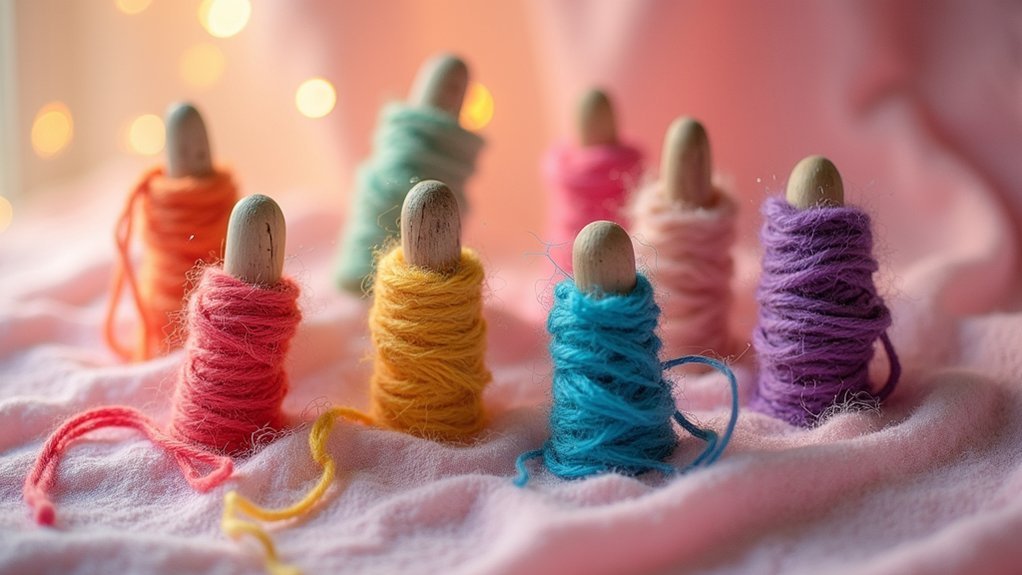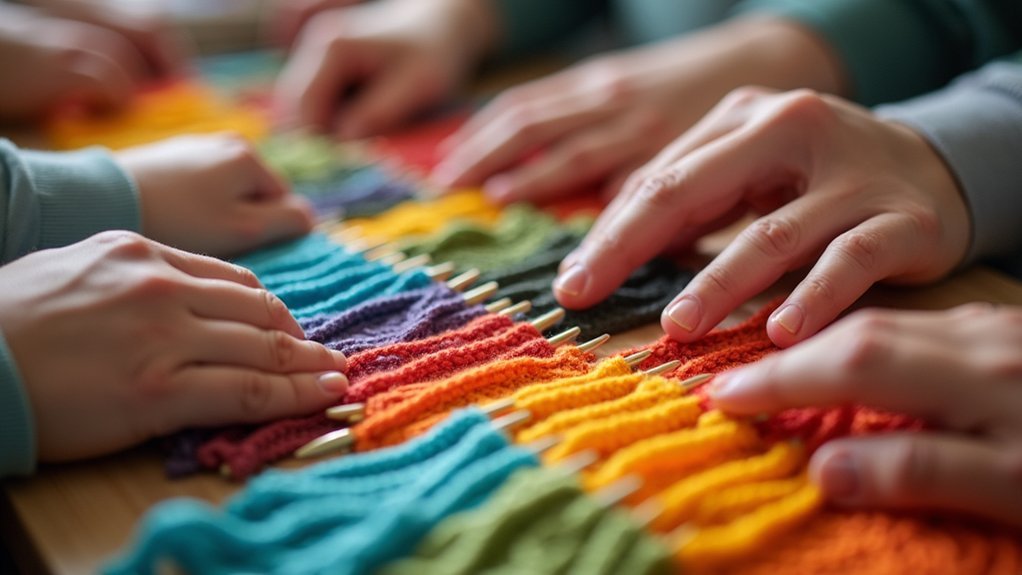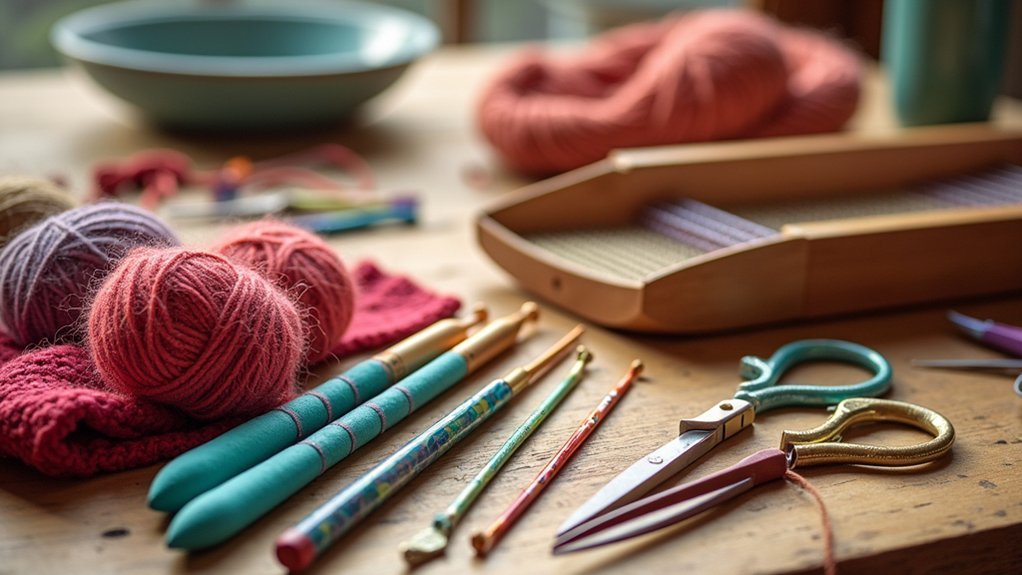Modern fiber arts tools now cater to diverse bodies and abilities. You’ll find adaptive yarn holders with ergonomic grips, voice-controlled looms enabling independent weaving, and sensory-enhanced knitting needles with customizable features. Modular crochet hooks with interchangeable attachments accommodate various hand sizes, while tactile pattern systems serve vision-impaired artists with raised designs and braille labels. These innovations guarantee that the joy of creating with fiber remains accessible to everyone, regardless of physical limitations.
Adaptive Yarn Holders With Ergonomic Grips

While traditional fiber arts tools can present challenges for many crafters, adaptive yarn holders with ergonomic grips have revolutionized accessibility in the crafting world.
These innovative tools feature breathable mesh designs that reduce tangling and maintain smooth yarn flow during use. You’ll find options with collapsible frames for easy storage and sturdy handles for effortless transport. The colorful foam grips add comfort while maintaining a secure hold on your tools during extended crafting sessions.
Breathable mesh yarn holders provide tangle-free crafting while convenient collapsible designs ensure easy storage between projects.
Whether you need a large holder for ambitious projects or smaller versions for portable crafting, there’s a size that fits your needs.
The ergonomic grips greatly reduce hand fatigue with their wider profiles and soft materials. They’re designed for both knife and pencil gripping styles, accommodating various hand sizes and preferences.
At affordable price points starting around $15, these tools make crafting more comfortable for longer sessions while minimizing pain associated with repetitive motions.
Voice-Controlled Loom Technology for Independent Weaving
Voice-controlled loom technology has emerged as a game-changing innovation for independent weavers who face physical limitations or mobility challenges.
You’ll find systems ranging from sophisticated computer-integrated Jacquard looms to simpler Raspberry Pi-powered designs, all accessible through voice commands.
These systems utilize speech recognition software to interpret your instructions, allowing you to focus on creative design rather than physical operation. The TC2 Loom’s computer control capabilities make it particularly well-suited for voice command integration.
Whether you’re working with a TC2 loom or a manual setup with treadle tracking, voice control can simplify your weaving process.
The benefits extend beyond disability accommodation—elderly weavers can extend their careers, beginners can navigate complex patterns more easily, and all users can execute intricate designs with less physical strain.
With Bluetooth and Wi-Fi connectivity options, you’re gaining unprecedented freedom in your fiber arts practice.
Sensory-Enhanced Knitting Needles With Customizable Features

Today’s knitting needles encompass far more than simple sticks for creating fabric—they’ve evolved into sophisticated tools that engage multiple senses while accommodating diverse physical needs. You’ll find options ranging from warm bamboo to cool metal, with ergonomic designs reducing hand fatigue during extended sessions. The innovative matte anodised needles provide greater control for knitters with looser styles, especially when working with slippery yarns.
| Material | Sensory Benefits |
|---|---|
| Bamboo | Warm touch, minimal sound |
| Wood | Natural texture, gentle on hands |
| Metal | Durable, smooth for speed |
| Anodized | Balanced grip and glide |
| Synthetic | Lightweight for reduced strain |
Interchangeable tips and adjustable cable lengths allow you to customize your tools for any project. For those with arthritis, lightweight aluminum options reduce strain, while wooden needles offer silent knitting for sensory-sensitive crafters. The right needle choice—whether for fuzzy, delicate, or slippery yarns—can transform your knitting experience.
Modular Crochet Hooks With Interchangeable Support Attachments
Modular crochet hooks represent a revolution in accessible fiber arts, expanding on the principles we’ve seen with adaptable knitting needles.
These versatile tools feature interchangeable handles and hooks of various sizes, allowing you to customize your crocheting experience based on your unique needs.
You’ll find these hooks particularly valuable if you experience hand fatigue or arthritis, as their ergonomic handles reduce strain during extended crafting sessions. QuillAndHive offers custom made arthritis-friendly handles at discounted prices when purchased with their interchangeable hook sets.
The interchangeability supports both standard and Tunisian crochet techniques, and some sets even offer compatibility with knitting needles.
Available at various price points ($40-$95), these sets prioritize accessibility through customizable components and diverse material options.
Whether you’re a beginner learning new stitches or an experienced crocheter seeking comfort, modular hooks offer tactile experiences that make fiber arts more inclusive for all bodies.
Tactile Pattern Systems for Vision-Impaired Fiber Artists

Revolutionizing fiber arts accessibility for those with vision impairments, tactile pattern systems translate visual designs into formats that can be understood through touch.
These systems employ raised-line drawings, textured symbols, and varied materials that create distinguishable patterns under your fingertips.
You’ll find several effective approaches including swell paper diagrams, embossed patterns, and thermoformed templates that maintain consistent tactile conventions.
Many incorporate braille labels alongside tactile elements to reinforce understanding.
Digital adaptations now offer haptic feedback devices and audio-enabled software that convert complex visual patterns into accessible formats.
When selecting tactile pattern systems, look for those with distinct texture differentiation and appropriate sizing.
The most successful designs emerge from collaborative testing with visually impaired artists, ensuring patterns are both accurately interpretable and practically usable in your creative process.
Some innovative systems integrate musical elements that help blind weavers develop a connection between sound and pattern creation, enhancing their artistic expression through sensory integration.
Frequently Asked Questions
How Do I Fund Adaptive Fiber Arts Tools on a Limited Budget?
You can fund adaptive fiber arts tools by applying for NEA or state grants, creating crowdfunding campaigns, seeking corporate sponsorships, organizing community fundraisers, or partnering with disability services programs that offer equipment resources.
Where Can I Find Inclusive Fiber Arts Communities in My Area?
You can find inclusive fiber arts communities by searching social media groups, local yarn shops, community centers, and libraries. Check websites like Meetup or Ravelry, or contact established fiber organizations in your region for recommendations.
What Maintenance Is Required for Accessibility Technology in Fiber Tools?
You’ll need to clean tools regularly, update software, perform mechanical checks, gather user feedback, and participate in training. Maintain environmental conditions like temperature, humidity, and light exposure for ideal performance of accessibility technologies.
Can Children With Disabilities Effectively Use These Inclusive Tools?
Yes, you’ll find children with disabilities thrive with these tools. They’re designed for various abilities, promoting motor skill development, cognitive engagement, sensory stimulation, emotional empowerment, and social interaction through creative expression.
How Do Seasonal Temperature Changes Affect Sensory-Enhanced Tool Functionality?
Seasonal temperature changes impact your sensory tools considerably. You’ll notice thermochromic pigments react differently, ionic liquid sensors require recalibration, and fiber optic components may drift in sensitivity during extreme weather conditions.
In Summary
You’ve now explored five innovative tools making fiber arts accessible to crafters of all abilities. Whether you’re adapting to mobility changes or seeking more comfortable crafting experiences, these options remove barriers to creativity. Don’t let physical limitations prevent you from enjoying the meditative benefits of fiber arts—embrace these inclusive solutions and you’ll discover new ways to express yourself through yarn, thread, and fabric.





Leave a Reply